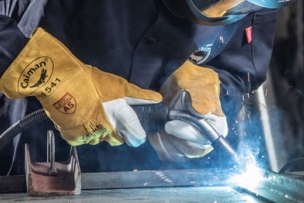What makes a good safety culture? It starts with passionate leaders who care for their employees, gain their trust and use attainable metrics while being truly committed to continuous improvement.
Enacting a policy geared toward safety compliance is one thing. Ensuring that action is promoted and carried out is a different matter entirely––one that safety experts say hinges on the attitude and practices of a company’s leadership toward the well-being of its employees and the rituals they build into their work and the company’s metrics.
“In companies with strong safety cultures, safety is embedded in daily management; it is part of the fabric of daily activity,” says Judy Agnew, a senior vice president at Aubrey Daniels International, in an article for EHS Today. “It infuses every interaction, every decision and every behavior. Unfortunately, in many organizations, leaders only attend to safety during safety meetings, audits and reactively, when there is an incident.”
Tanis Marquette, CSP ISSP-CSP and global sustainability leader for Hexion Inc., shares that sentiment.
“Companies that embed safety as a core value, integrated into every aspect of work, are able to demonstrate not only their commitment to worker safety but a consistent improvement in results because safety is widely visible,” she says. “Safety is everyone’s responsibility, and every job, function and department plays a role, from top to bottom.”
Creating a Safety Culture From Caring
Actions speak louder than words. But for many managers and business owners who might not be so adept at building a culture of safety from scratch, actions in the form of policies and procedures might not be enough.
“Safety training is emotional,” explains Frank Quarato, founder, president and safety expert for the Center for Safety & Environmental Management (CSEM). “And to change culture, you have to evoke passion.”
Quarato and his team travel across the country helping to conduct on-site safety trainings for manufacturers. When speaking with a company’s leadership, he drives home the necessity to be on the ground level.
“When you see that your boss cares for you, the relationship really transforms,” he stresses. “Once employees start to see that leadership recognizes their contributions and actually sees the work being done, there’s a newfound sense of trust and respect there.”
That trust, according to Quarato, lays the foundation for a culture of safety. In that same vein of emotion, however, he also explains that fatality and injury can have this same effect. He often cites examples in his trainings, which frequently leaves the students with their mouths agape.
“Whether that’s through leadership showing they care or through something as serious as incidents occurring, triggering an emotional response is the quickest way to project a culture of safety.”
Safety Culture Does Not Trickle Down
Oftentimes, manufacturers tend to see safety as a message (whether that’s through a mission statement or handbook policy) that trickles from the top to the bottom. But as Quarato explains, that message needs to be delivered––and made an example of––on the ground level.
“When it comes to creating a culture of safety, it’s critical for everyone in the company, especially leadership, to see through the optic of everyone else,” he says. Quarato encourages senior leadership and human resources to attend trainings alongside regular employees.
There’s nothing wrong with leadership pursuing production or financial goals aggressively. But when those big goals begin to drive workers to complete tasks hastily or to find shortcuts, staff safety is in jeopardy.
Using a steel manufacturing company as an example, a study that examined safety from a worker perspective at a steel mill in Sweden found that workers under duress from tight deadlines were more likely to seek timesaving and dangerous shortcuts. And it’s not just a matter of pursuing a 5 o’clock pullout time from the parking lot. Workers in the study were concerned for their colleagues, too, and didn’t want to leave extra work for that individual taking over their shift.
“You reach your business goals by incorporating safety, not skating by it,” explains Quarato. “When employers implement safe policies that show they care about their employees, their staff is inspired to work better and harder. Safety shouldn’t be a hindrance.”
Safety Culture Means Listening to Workers on What Works for Them
Personal protective equipment that’s ill-fitting, uncomfortable or time-consuming to put on could also be causing employees to seek dangerous shortcuts. Marquette has a solution for that.
“A culture of safety begins with empowering workers,” she explains. “Let’s look at the selection of personal protective equipment as an example. Integrating workers into the solution-development process will lead to a greater level of embracement and recognition of issues in use before they become injuries.”
“New chemical gloves should include ‘road testing’ to ensure they are appropriately protective, easy to get on and off, and do not pose any unintended hazards during use,” Marquette says. “Under safety supervision, workers should complete their tasks using the new gloves, and then provide feedback. With appropriate training, education and awareness, the person using the gloves is often the best person to advise if they effectively reduce the risk they were intended to mitigate. Safety is everyone’s responsibility.”
"Safety is everyone's responsibility, and every job, function and department plays a role, from top to bottom."
Selecting the Right Safety KPIs for Your Culture
If a business has a reduced number of accidents (or zero accidents all together), the company might even be tempted to translate its better-than-average accident scores into a key performance indicator itself, but those figures could be a facade, warns Terry Mathis, founder and CEO of ProAct Safety, in an article for EHS Today. Accidents are a combination of failure to follow procedures and being simply unlucky. Therefore, it’s dangerous to tie a low accident frequency to a reduced need to spend on safety training, surmises Mathis.
“Too many organizations still measure safety largely or exclusively via incident rate (or similar lagging metrics such as DART, lost-time case rate, severity rate, etc.),” says Agnew. “Such measures tell us how many people got hurt and how badly, but they are not good measures of what leaders are doing to prevent accidents and incidents.”
Think of it this way: Having a low accident rate could also be pure luck and you could still have an unsafe workplace without a culture around it to help promote the right behaviors of prevention. In that way, accidents and safety are not mutually exclusive.
“The majority of measures should focus on proactive behaviors on the part of all employees—measures that track what people are doing to prevent accidents,” says Agnew. “When there are measures of what leaders do on a daily and weekly basis to prevent accidents, immediate and certain consequences can be engineered in to ensure those activities occur.”
How does your company foster a culture of safety? Let us know in the comments below.





Talk to Us!
Leave a reply
Your email address will not be published. Required fields are marked *